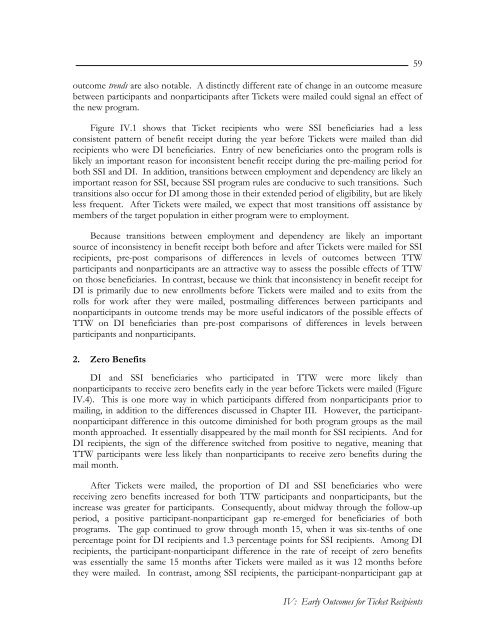Evaluation of the Ticket to Work Program, Implementation ...
Evaluation of the Ticket to Work Program, Implementation ...
Evaluation of the Ticket to Work Program, Implementation ...
You also want an ePaper? Increase the reach of your titles
YUMPU automatically turns print PDFs into web optimized ePapers that Google loves.
outcome trends are also notable. A distinctly different rate <strong>of</strong> change in an outcome measurebetween participants and nonparticipants after <strong>Ticket</strong>s were mailed could signal an effect <strong>of</strong><strong>the</strong> new program.Figure IV.1 shows that <strong>Ticket</strong> recipients who were SSI beneficiaries had a lessconsistent pattern <strong>of</strong> benefit receipt during <strong>the</strong> year before <strong>Ticket</strong>s were mailed than didrecipients who were DI beneficiaries. Entry <strong>of</strong> new beneficiaries on<strong>to</strong> <strong>the</strong> program rolls islikely an important reason for inconsistent benefit receipt during <strong>the</strong> pre-mailing period forboth SSI and DI. In addition, transitions between employment and dependency are likely animportant reason for SSI, because SSI program rules are conducive <strong>to</strong> such transitions. Suchtransitions also occur for DI among those in <strong>the</strong>ir extended period <strong>of</strong> eligibility, but are likelyless frequent. After <strong>Ticket</strong>s were mailed, we expect that most transitions <strong>of</strong>f assistance bymembers <strong>of</strong> <strong>the</strong> target population in ei<strong>the</strong>r program were <strong>to</strong> employment.Because transitions between employment and dependency are likely an importantsource <strong>of</strong> inconsistency in benefit receipt both before and after <strong>Ticket</strong>s were mailed for SSIrecipients, pre-post comparisons <strong>of</strong> differences in levels <strong>of</strong> outcomes between TTWparticipants and nonparticipants are an attractive way <strong>to</strong> assess <strong>the</strong> possible effects <strong>of</strong> TTWon those beneficiaries. In contrast, because we think that inconsistency in benefit receipt forDI is primarily due <strong>to</strong> new enrollments before <strong>Ticket</strong>s were mailed and <strong>to</strong> exits from <strong>the</strong>rolls for work after <strong>the</strong>y were mailed, postmailing differences between participants andnonparticipants in outcome trends may be more useful indica<strong>to</strong>rs <strong>of</strong> <strong>the</strong> possible effects <strong>of</strong>TTW on DI beneficiaries than pre-post comparisons <strong>of</strong> differences in levels betweenparticipants and nonparticipants.2. Zero BenefitsDI and SSI beneficiaries who participated in TTW were more likely thannonparticipants <strong>to</strong> receive zero benefits early in <strong>the</strong> year before <strong>Ticket</strong>s were mailed (FigureIV.4). This is one more way in which participants differed from nonparticipants prior <strong>to</strong>mailing, in addition <strong>to</strong> <strong>the</strong> differences discussed in Chapter III. However, <strong>the</strong> participantnonparticipantdifference in this outcome diminished for both program groups as <strong>the</strong> mailmonth approached. It essentially disappeared by <strong>the</strong> mail month for SSI recipients. And forDI recipients, <strong>the</strong> sign <strong>of</strong> <strong>the</strong> difference switched from positive <strong>to</strong> negative, meaning thatTTW participants were less likely than nonparticipants <strong>to</strong> receive zero benefits during <strong>the</strong>mail month.After <strong>Ticket</strong>s were mailed, <strong>the</strong> proportion <strong>of</strong> DI and SSI beneficiaries who werereceiving zero benefits increased for both TTW participants and nonparticipants, but <strong>the</strong>increase was greater for participants. Consequently, about midway through <strong>the</strong> follow-upperiod, a positive participant-nonparticipant gap re-emerged for beneficiaries <strong>of</strong> bothprograms. The gap continued <strong>to</strong> grow through month 15, when it was six-tenths <strong>of</strong> onepercentage point for DI recipients and 1.3 percentage points for SSI recipients. Among DIrecipients, <strong>the</strong> participant-nonparticipant difference in <strong>the</strong> rate <strong>of</strong> receipt <strong>of</strong> zero benefitswas essentially <strong>the</strong> same 15 months after <strong>Ticket</strong>s were mailed as it was 12 months before<strong>the</strong>y were mailed. In contrast, among SSI recipients, <strong>the</strong> participant-nonparticipant gap at59IV: Early Outcomes for <strong>Ticket</strong> Recipients
















